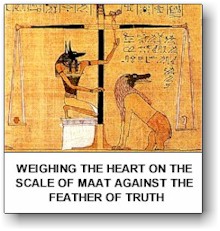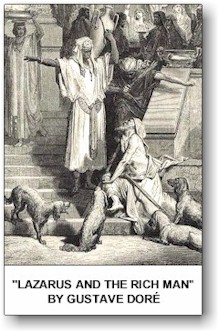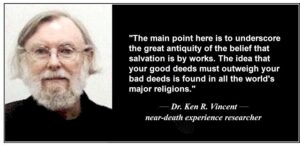This site uses affiliate links to Amazon.com Books for which IANDS can earn an affiliate commission if you click on those links and make purchases through them.
1. The Parallels Between the Moral Development of an Individual and Entire Cultures Throughout History
“When I was a child, I spoke as a child, I thought as a child, I reasoned as a child, but when I became a man I put away childish ways.” (1 Corinthians 13:11)
This familiar passage of St. Paul describes normal human development.
My thesis is that there is a parallel between the development of the individual and the progress of whole cultures throughout history and that evidence for this maturation process can be found in the stories of the world’s religions. Because the Bible documents a 2000-year period of human development, it is particularly rich with examples of developmental revelation.
There are many approaches to studying human development and religion, and these are reflected in the research of developmental psychologists like Jean Piaget, Erik Erikson, Jane Loevinger, and others. James Fowler, who is both a psychologist and theologian, devised a compelling list called, “Seven Stages of Faith Development.”
The theory of human development with the most cross-cultural and comparative religious research to its credit (and my personal favorite) is that of Larry Kohlberg. It is the one I have selected to explore with you in greater detail. To date, the consensus of his research shows that, when education and socioeconomic status are controlled for, human beings around the world from all faiths and cultures vary widely among themselves and that no faith or culture is clearly superior.
2. Kohlberg’s Three Levels of Moral Development
According to Kohlberg, there are three levels of moral development, each of which has two stages:
a. The Pre-Conventional Level of Moral Development
b. The Conventional Level of Moral Development
c. The Post-Conventional Level of Moral Development
It is important to realize that not all people reach all stages of development, neither in the past nor today.
a. The Pre-Conventional Level of Moral Development
I. The First Stage of Pre-Conventional Morality: Punishment and Obedience Orientation
The “pre-conventional” level is the most remedial, and its first stage is called the “punishment and obedience orientation”. This is the stage of pre-schoolers. The child at this stage lacks the mental structure to understand the rules but does understand rewards and punishment.
Children at this age are not educable, but they are trainable. This is also the moral level of your dog or cat.
Consider this example: At about age 3 or 4 years, your daughter has figured out that pushing the chair up to the kitchen counter will allow her to get to the cookie jar. Later, you come into the kitchen, see the chair and the empty cookie jar with its lid off, and you see the child with crumbs all over her face. When you ask,, “Did you take the cookies?”, your child gives the “right” answer — “No, I didn’t take the cookies!” The parent is often devastated, assuming that his child is not only STEALING but LYING! The parent fails to realize that the child does not yet make the connection between cause and effect. Thankfully, very few adults remain stuck at this moral level.
In the Bible, the best-known example of this is the second Creation Story (Genesis 2:4; Genesis 3:24) in which you might substitute the “forbidden fruit” for the cookie jar. Adam takes no personal responsibility but blames Eve for giving him the fruit, and Eve blames the snake for her misbehavior!
In the same story in Genesis, we are introduced to the oldest form of punishment — the banishment of Adam and Eve from Paradise. As demonstrated in the work of Jane Goodall, this links us with the behavior of baboons who banish members of their clan for “crimes” of dominance, sex, and murder.

In the 5,000-year-old Egyptian Book of the Dead, this stage of morality is reflected in the behavior of the deceased who is expected to lie to the god Osiris in the Afterlife by reciting a magic formula known as the Negative Confession in which he denies all wrong-doing. We see this same magic formula in the Christian theology of “Jesus Saves.” All one needs to know is John 3:16 and/or John 14:6. This is a gross distortion of the teachings of Jesus. Another Christian theology at this level is Predestination. In predestination, individuals cannot influence their own salvation and like the small child have no understanding of the reason for the rules. Before we leave the level of “magic” in human development, it is important to note that in times of distress, any of us may want a little magic! In Hinduism, it is said that if you die with the name of the god Vishnu or one of his incarnations like Rama or Krishna on your lips, all your sins will be taken away. Gandhi, who achieved the highest level of spiritual development, died with the name of Rama on his lips!
II. The Second Stage of Pre-Conventional Morality: Reciprocity
The second stage of “pre-conventional morality” is that of reciprocity. This is the stage most of us reached in elementary school and is adopted to satisfy personal needs. At this stage, the rules exist to be manipulated. Children will give favors in order to get similar rewards in return. They discover that they can make “deals”, i.e., “if you scratch my back, I’ll scratch yours”. A child will say, “I don’t want to play that game. That is YOUR game, and we played that yesterday. Today is MY turn.” Even in modern times, some adults get stuck at this stage.
Obviously, this level includes primitive religions in which an animal or human is sacrificed as a bribe to the gods with the understanding that the gods will do (or not do) something for the worshipers. Also, the idea in the Hebrew Bible that the righteous will always prosper, and that if something bad happens to you, it’s because you have sinned belongs at this level. Some years ago, a student told me of working at an affluent church school that did not admit handicapped students; because it was evidence that their parents had sinned. In the Book of Job, Job’s friends express this view. The Prayer of Jabez is a “give me” prayer and at this level.
In the Bible, this level of morality is also represented in the law of:
“An eye for an eye and a tooth for a tooth.” (Exodus 21:24)
Getting stuck with this mentality can lead to barbarism and reminds us of the relentless retaliatory strikes we hear about on the evening news between the Israelis and Palestinians. Unless people are encouraged to higher levels of thinking, in the words of Martin Luther King, we are all at risk of becoming “blind and toothless”. The only good thing about this rule is that you are only allowed to take one eye for one eye and one tooth for one tooth.
Many of those to whom Moses preached were no doubt at either the first or second stage of “pre-conventional” morality — largely equivalent to that of today’s small children. It also appears that the people addressed by Muhammed 2000 years later were at this level.
b. The Conventional Level of Moral Development
I. The First Stage of Conventional Morality: The “Good Boy / Nice Girl” Phase
The next level of moral reasoning is the “conventional” level which is reached by most people in adolescence; most adults never progress beyond one of its two stages. The first of these stages is the “good boy/nice girl” phase in which “right” behaviors are the ones that please the person’s reference groups, including family, friends, and peers. This is the first stage that goes beyond the manipulation of others for personal gratification and includes a genuine consideration for others. It is the first level at which the Golden Rule can be understood, if not practiced.
In the Bible, the beautiful story of Ruth reflects this level of development when she declares:
“Where you go I will go, and where you lodge I will lodge; your people shall be my people, and your God my God.” (Ruth 1:16)
Although this love passage is sometimes used for modern weddings, Ruth is not saying this to her husband — she is addressing her mother-in-law, Naomi. Ruth wants to remain with her mother-in-law because she loves her — not because she thinks Naomi’s God is superior!
This is the stage where the need for a personal god is strongest. In Hinduism this is the devotional path exemplified by the worshipers of Lord Krishna:
“Krishna, Krishna, Hari, Hari”: Krishna, Krishna, Redeemer, Redeemer.
In Christianity, we see this manifested in those kind and loving people that model their lives on Jesus. One is reminded of the words of the beautiful old hymn, In the Garden:
“And he walks with me and he talks with me and he tells me I am his own…”
II. The Second Stage of Conventional Morality: The View of “Law and Order”
The second stage of the “conventional” level of morality is compatible with the view of “law and order”. At this stage, morality is defined as “doing one’s duty” and “obeying the rules”. At this stage, rules are “right” because they have been formulated by one’s superiors — a prophet, king, judge, president, or priest. This represents a step upward because, for the first time, the values of society as a whole are placed above the needs of the individual, his close family, or his friends. This is the mentality of “my country right or wrong.”
In the Bible, this is the mentality of the Ten Commandments (Exodus 20:1-17) and represents the stern but fair God of Moses and Mohammed.
Returning to ancient Egyptian religion, the concept of the justice of weighing of the departed good deeds is reinstated. As in Christianity, it co-exists with magic (e.g., The Book of the Dead‘s magic formula of Salvation and Christianity’s “Jesus Saves”). The story appears of a grandson of Rameses II named Sa-Osiris, who is a seer, and his father. They were watching a funeral procession in which a rich man was being carried with his elaborate belongings to a princely tomb. Shortly after this, they observed the funeral of a poor man wrapped only in a cloth who was being taken for burial in the desert sand.
The Egyptian prince remarks to his son that he hopes for a good funeral in preparation for a glorious afterlife, but his seer son remarks that all things are not as they appear to be. He puts his father into a trance, and the two are transported to the land of the dead where the evil rich man is suffering a hellish fate and the righteous poor man is being comforted by Osiris, Isis, and the Egyptian gods, and is living afterlife in regal splendor.

This shows the development of morality and justice in the Egyptian religion, and some Christian scholars think this is the origin of the story of the rich man and Lazarus in the Gospel of Luke (Luke 16:19-31). The main point here is to underscore the great antiquity of the belief that salvation is by works. The idea that your good deeds must outweigh your bad deeds is found in all the worlds’ major religions. In ancient Egypt it is Anubis, the jackal headed god, who holds the scales of justice, in Christianity it is the Archangel Michael, in Islam it is the Archangel Gabriel, in Zoroastrianism it is the angel Rashnu, and in both Hinduism and Buddhism it is the yamadoots of the god of death Yama. In the Eastern Religions, Yama presides over both your fate in the intermediate state between death and rebirth, and your reincarnation. It is worth noting that salvation by works is the predominant message in the New Testament with 389 of the 551 verses supporting it on the lips of Jesus himself. The Unitarian William Ellery Channing called it “salvation by character.”
According to Kohlberg, MOST of humanity will remain at this “conventional” stage of moral development.
c. The Post-Conventional Level of Moral Development
I. The First Stage of Post-Conventional Morality: The Democratic Social Contract
Only one-third of humanity will reach the “post-conventional” level of morality. The first of its two stages is called, “the democratic social contract”, and one-fourth of modern adults achieve this level. To these people, rules are obeyed because there is a consensus of the electorate.
Also, the rules can be CHANGED whenever the majority of people agree to change them. The government of the United States is based on this level of morality, as were (to some extent) the governance of the early Christian church which, among other things, ordained women (Romans 16:1). While God’s laws are unchangeable, the ways religions operate can and do change. Also, Process Theology fits here (i.e., the idea that God has endowed the Universe with free will and that we are co-creators with God). While Process Theology is a hot topic in today’s divinity schools, the idea that we are co-creators with God in helping bring about the perfection of the world is as old as Zoroaster. In the New Testament, you find this idea in Acts 3:20-21 and 2 Peter 3:11-13.
II. The Second Stage of Post-Conventional Morality: Universal Ethical Principle
A. Post-Conventional Morality in Various World Religions
The final stage of “post-conventional” moral development is that of the “universal ethical principle”, and only about 10% of humanity functions at this level. It recognizes a universal connection to nature, to each other, and to God. At this stage, the rights of each individual are as important as the rights of the majority, and the individual follows the dictates of his or her conscience while at the same time being aware of the rights of others. This person is aware that what is “right” and what is “legal” may not be the same and that the dictates of conscience must be followed.

This stage is epitomized by the Golden Rule, often associated with Christianity but present in virtually all of modern mainstream religions. Zoroaster does not need to give his followers a commandment that prohibits murder — he does tell them that their good thoughts, words, and deeds are required to help God defeat evil in this world.
Lao Tzu says: “Respond to anger with virtue.”
And the Buddha tells us to: “Overcome anger by love; overcome evil by good.”
Within Islam, the sect called Sufis strives to reach a sublime level of mystic union with God.
A Sufi motto is: “It’s not the letter, it’s the spirit.”
In Judaism, this highest level is epitomized by the Book of Isaiah. Gandhi’s tactics of civil disobedience were a good example of “post-conventional” thinking leading to action, making the world better.
In the Bible, the whole of Jesus’ message of love and kindness speaks to this highest level.
Think of the difficulty of his simple-sounding formula:
“Do unto others as you would have them do to you … Judge not … Forgive and you will be forgiven … Blessed are the peacemakers … Turn the other cheek … Let him who is without sin cast the first stone … Love your enemies … It is not what goes into your mouth but what comes out that is important.”
You may recall from stories in the New Testament that Jesus himself encounters people who clearly could not comprehend his message. More than once he simply refers them back to:
I. The Ten Commandments (Matthew 19:16-20, Mark 10:17-20, Luke 18:18-20).
II. Or to the two Great Commandments, i.e., to love God and to love your neighbor (Matthew 22:37-40, Mark 12:28-34, Luke 10:25-28).
III. At the highest level: forgiveness is yours for the asking (Matthew 6:12; Matthew 7:7-11).
IV. And salvation is Universal (Matthew 18:14, Luke 3:6; 1 Timothy 4:10; Hebrews 10:15-17).
Every mystic knows that we will all be reconciled with God, and Universal Restoration is a minority theme in all the world’s religions. Zoroaster, Jesus, and Bahá’u’lláh mention universalism directly; the Rabbis of the Midrash tell us that one cannot stay in Hell over one year! In the Hadith, Muhammad predicts that there will be a time when Hell is empty of humans. In Eastern religions, reincarnation offers the hope for universal redemption.
When we look at religions in modern times, it is clear that some have a broad appeal and others have a more narrow appeal. I think that the greatest risk for individual believers is to get “stuck” in a religious community that does not value personal growth. I have personally met people (including some ministers) whose intellect and spiritual experience have awakened them to a higher level of morality but whose congregations have discouraged or prohibited them from their pursuit.
B. Farhat-Holzman’s Analysis of Some Religions Acceptance of People at All Levels of Development
In her analysis of the behavior of believers, the historian Laina Farhat-Holzman contends that some religious movements are accepting of persons at all levels of development and consciously make room for:
I. Those persons who base their belief on the “magic” of holy relics.
II. Those persons whose religion is confined to ritual.
III. Those persons who struggle to understand the teachings of their prophets.
C. An Example of One Religion’s Moral Development from the Lowest to the Highest Throughout History
Two excellent examples of religions that span the range of moral development from the lowest to highest levels are Roman Catholic Christianity and Hinduism.
In scholarly literature, the results of objective studies are mixed when analyzing the differences between denominations or religions. The most consistent finding has been that fundamentalists have a lower level of moral development than liberals. Interestingly, this appears to be true for those liberals professing no religion, as well as for those who practice Christianity or another religion. Some fundamentalist Christians have charged that these attempts at objective measurements have been biased; however, I believe that there is an alternate explanation.

Developmental psychologists have known for some time that people can truly understand only the moral stages just above and just below their own. Moses was above the masses of Jews of his time but NOT so far ahead that they could not understand him. Jesus was speaking to a more sophisticated group morally, one that had already been socialized by the “conventional” rules of Moses. In other words, Moses HAD to happen BEFORE Jesus could happen. If Jesus had confronted the people of the Exodus with, “Love thy neighbor…”, his message would not have been understood by them.
Often we religious liberals are hard on fundamentalists whom we accuse of being literal, concrete, and rule-bound. However, I must come to their defense with regard to this fact: these “conventional” people with specific messages are the ones most able to appeal to those at the level of “pre-conventional” morality and help raise them up. Although we reject their religious message and viewpoints, it is good to remember that humanity must crawl before it can walk. Years ago, an optimistic friend of mine questioned a fundamentalist who explained that:
“We are fundamentalists because we NEED the tight controls of a ‘Thou Shalt Not’ morality; otherwise, we would go wild!”
Another important truism for religious liberals to remember is that ALL children must pass through ALL stages of morality. No matter how intelligent your child may be, her moral maturity cannot be inherited at birth! All children need to experience structure and kindness so that they can develop to the stage where the Golden Rule can be understood and, ultimately, to the level where it can be lived. Research into how to accomplish this is mixed, but activities which require reasoning and exploration of moral issues appear to foster a progression toward the “post-conventional” level. Adults who have had an opportunity in college to explore moral issues must continue to find forums for discussion, reasoning, and moral growth. I think that this is an excellent challenge for Sunday Schools and Adult Education programs in our churches!
In closing, I’d like to express my own opinion about developmental revelation expressed in the Biblical stories. Although the stories of the Old Testament are part of our literary culture, Christianity has wallowed too long in their primitive “pre-conventional” morality. And although there is nothing more beautiful than the declaration of St. Paul that “love is patient and kind,” many churches have allowed themselves to stagnate in his largely “conventional” message.
In the recent past, a movement has been gradually growing which takes seriously the “post-conventional” morality of the teachings of Jesus in the Gospels. In my view, this should be the predominant message heard in our churches, inspiring people to “climb up” to the next rung on the moral ladder. But it’s easier to worship Jesus than to follow his teachings. The “post-conventional” morality of Jesus demands that we live in the Kingdom of God RIGHT NOW — that it is possible to be ONE with the Father. In the Gospel of Luke, Jesus proclaims that:
“The Kingdom of God is within you.” (Luke 17:21)
We need to call it forth for the sake of ourselves, for the sake of all humanity, and for the sake of our whole planet.





















